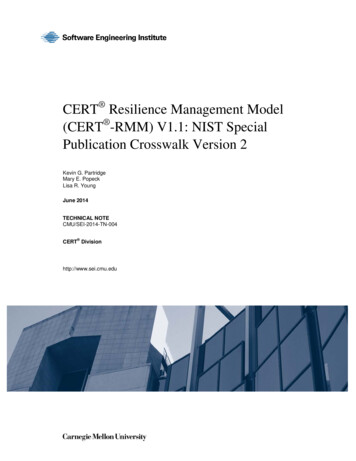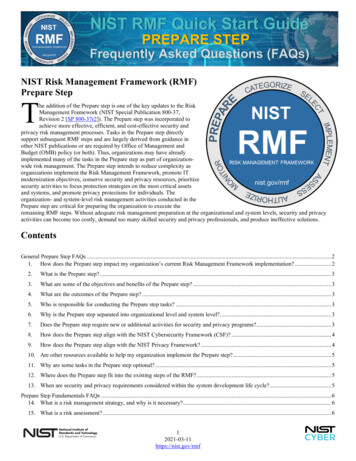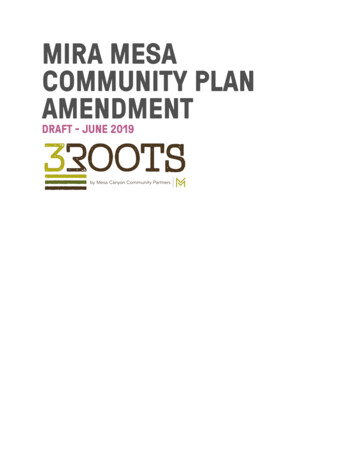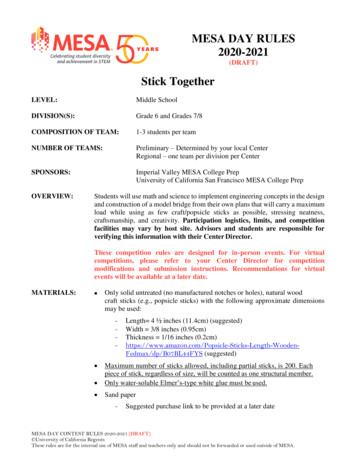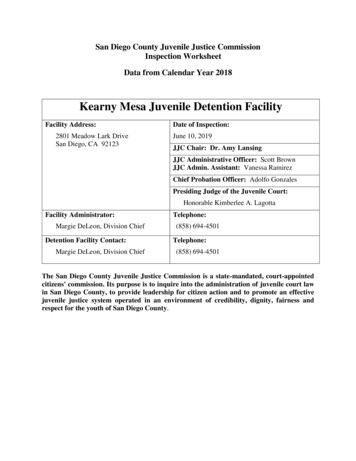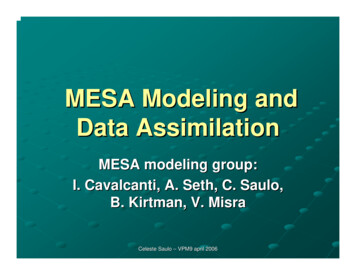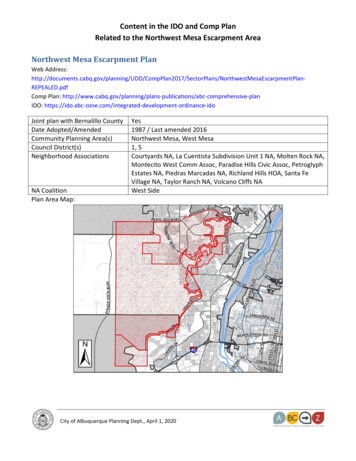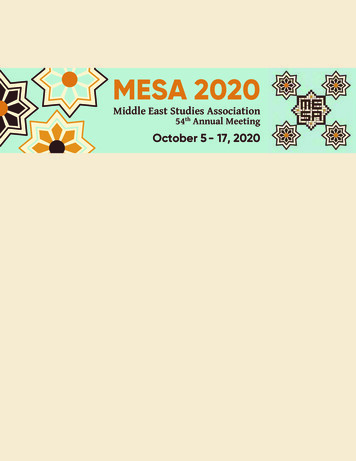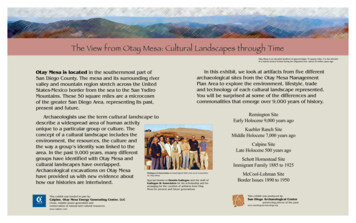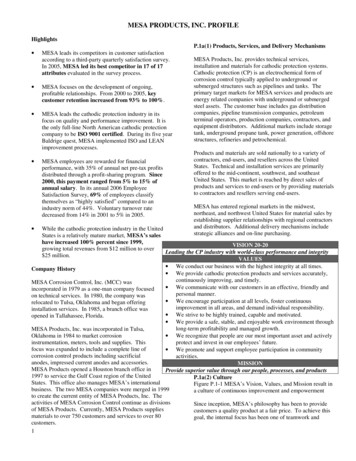
Transcription
MESA PRODUCTS, INC. PROFILEHighlightsP.1a(1) Products, Services, and Delivery Mechanisms MESA leads its competitors in customer satisfactionaccording to a third-party quarterly satisfaction survey.In 2005, MESA led its best competitor in 17 of 17attributes evaluated in the survey process. MESA focuses on the development of ongoing,profitable relationships. From 2000 to 2005, keycustomer retention increased from 93% to 100%. MESA leads the cathodic protection industry in itsfocus on quality and performance improvement. It isthe only full-line North American cathodic protectioncompany to be ISO 9001 certified. During its five yearBaldrige quest, MESA implemented ISO and LEANimprovement processes. MESA employees are rewarded for financialperformance, with 35% of annual net pre-tax profitsdistributed through a profit-sharing program. Since2000, this payment ranged from 5% to 15% ofannual salary. In its annual 2006 EmployeeSatisfaction Survey, 69% of employees classifythemselves as “highly satisfied” compared to anindustry norm of 44%. Voluntary turnover ratedecreased from 14% in 2001 to 5% in 2005.MESA Products, Inc. provides technical services,installation and materials for cathodic protection systems.Cathodic protection (CP) is an electrochemical form ofcorrosion control typically applied to underground orsubmerged structures such as pipelines and tanks. Theprimary target markets for MESA services and products areenergy related companies with underground or submergedsteel assets. The customer base includes gas distributioncompanies, pipeline transmission companies, petroleumterminal operators, production companies, contractors, andequipment distributors. Additional markets include storagetank, underground propane tank, power generation, offshorestructures, refineries and petrochemical.Products and materials are sold nationally to a variety ofcontractors, end-users, and resellers across the UnitedStates. Technical and installation services are primarilyoffered to the mid-continent, southwest, and southeastUnited States. This market is reached by direct sales ofproducts and services to end-users or by providing materialsto contractors and resellers serving end-users.MESA has entered regional markets in the midwest,northeast, and northwest United States for material sales byestablishing supplier relationships with regional contractorsand distributors. Additional delivery mechanisms includestrategic alliances and on-line purchasing.While the cathodic protection industry in the UnitedStates is a relatively mature market, MESA’s saleshave increased 100% percent since 1999,VISION 20-20growing total revenues from 12 million to overLeading the CP industry with world-class performance and integrity 25 million.VALUES We conduct our business with the highest integrity at all times.Company History We provide cathodic protection products and services accurately,continuously improving, and timely.MESA Corrosion Control, Inc. (MCC) was We communicate with our customers in an effective, friendly andincorporated in 1979 as a one-man company focusedpersonal manner.on technical services. In 1980, the company was We encourage participation at all levels, foster continuousrelocated to Tulsa, Oklahoma and began offeringimprovement in all areas, and demand individual responsibility.installation services. In 1985, a branch office was Westrive to be highly trained, capable and motivated.opened in Tallahassee, Florida. We provide a safe, stable, and enjoyable work environment throughlong-term profitability and managed growth.MESA Products, Inc. was incorporated in Tulsa,Oklahoma in 1984 to market corrosion We recognize that people are our most important asset and activelyprotect and invest in our employees’ future.instrumentation, meters, tools and supplies. Thisfocus was expanded to include a complete line of We promote and support employee participation in communitycorrosion control products including sacrificialactivities.anodes, impressed current anodes and accessories.MISSIONMESA Products opened a Houston branch office inProvide superior value through our people, processes, and products1997 to service the Gulf Coast region of the UnitedP.1a(2) CultureStates. This office also manages MESA’s internationalFigure P.1-1 MESA’s Vision, Values, and Mission result inbusiness. The two MESA companies were merged in 1999a culture of continuous improvement and empowermentto create the current entity of MESA Products, Inc. Theactivities of MESA Corrosion Control continue as divisionsSince inception, MESA’s philosophy has been to provideof MESA Products. Currently, MESA Products suppliescustomers a quality product at a fair price. To achieve thismaterials to over 750 customers and services to over 80goal, the internal focus has been one of teamwork andcustomers.1
shared goals. Initially, the team effort was focused onbusiness survival. Now, the effort is focused on continuousimprovement, continued growth and long-term success. Thework environment is characterized by the words “friendly”,“personal”, “fair”, “enjoyable”, “safe”, and “stable”. Thesewords describe MESA’s culture, defined in the Vision,Values, and Mission (Figure P.1-1).P.1a(3) Human ResourcesMESA currently has a workforce of 75 full-time employees.The company employs a diverse group of professional,administrative, technical, construction, and manufacturingpeople in a close-knit, non-union environment. The generalhiring philosophy is to attract and retain valuableemployees. Although sales revenue exhibits significantseasonal variations (100% variation from January/Februaryto September/October), the workforce is not seasonallyadjusted. MESA feels its employee assets (Figure P.1-2)are too valuable to reduce workforce in the slow periods andnot have them available in the busy periods. MESA hasnever experienced a planned workforce reduction, otherthan involuntary performance related terminations.AGE40.5 years oldTENUREGENDER7.3 nt10%High School61%Admin/Sales31%Some College 24%Plant30%Degree15%Field29%Figure P.1-2 MESA’s workforce is stable and diverse2Within the MESA employee base, there is a wide range ofeducational and technical background. MESA hasprofessional engineers along with knowledgeableconstruction workers to assist customers in the designphase. MESA has developed electronic capabilities forsystem design that are available internally and externally forcustomer or general public use. These design tools areavailable at no charge on the MESA website as the CPDesign Center. This e-business technology is the first andlargest of its kind in the cathodic protection industry.Personal interviews, informal feedback from customers, andreview of competitor sites confirm the value and position ofthe CP Design Center as an industry leading resource.Much of the equipment used for manufacturing at MESA isunique to the industry and has been developed and builtbased on needs and in-house expertise. These include a gundrill used for boring of graphite anodes, custom materialcarts, racks, and wire winding equipment. MESA ownsheavy construction equipment such as backhoes, augertrucks and trenching TYCaucasian75%African American 9%Native American10%Hispanic6%For hourly, unskilled positions, MESA uses temporaryagencies to screen and supply personnel. Temporaryemployees are converted to full-time employees uponsuccessful completion of a 6–12 month probationary period.Installation and field service personnel are carefullyscreened through temporary agencies. Depending onexperience and qualifications, they may be hiredimmediately or retained through a temporary agency for anundefined probationary period. Administrative and salariedpersonnel are typically hired after careful review ofqualifications, experience and needs. This philosophy hasresulted in a stable, experienced, qualified staff with a lowturnover rate, particularly in key employee positions.The personal safety and health of each employee is ofutmost importance. MESA strives to provide a safe andhealthy working environment for all personnel through theapplication of an effective and continuous safety program.MESA has developed formal programs to meet theseobjectives. Since its inception, MESA has neverexperienced an accident resulting in permanent injury ordeath. There are no unique health or safety requirements.MESA emphasizes employee wellness through an on-sitephysician and annual health screenings.P.1a(4) Technologies, Equipment and FacilitiesCorporate headquarters and primarymanufacturing plant are located in thecentral part of Tulsa. In 2002, MESAcreated a training facility withclassroom space and an outdoor trainingfield with underground piping andtanks.P.1a(5) Regulatory EnvironmentBeyond the workplace environment regulations of OSHA,MESA operations are also significantly impacted by DOTregulations in three primary areas. In order to performservices for DOT regulated pipeline customers, MESA isrequired to maintain Anti-Drug and Alcohol programs andmeet Operator Qualification requirements for anyemployees directly working on regulated pipelines.Additionally, MESA must comply with DOT drivingregulations in the operation of its mobile constructionequipment. Other regulatory agencies with which MESAinteracts include the Environmental Protection Agency,Oklahoma Corporation Commission, Texas RailroadCommission, and Kansas Corporation Commission.Specialized safety training is often required by clients;including excavation and confined space entry. ISO 9001certification requires two audits annually by an outside auditfirm. There are no corporate certifications or licenses in theCP industry.
Cathodic protection is required by federal and stateregulations governing underground transmission pipelinesand natural gas distribution systems. These requirementsinclude installation, monitoring, and maintenance. Thefederal Department of Transportation has jurisdiction overinterstate operators. State agencies such as the OklahomaCorporation Commission assume jurisdiction for intrastateoperators. Similar regulations regarding underground tanksfall under the jurisdiction of the Environmental ProtectionAgency and/or state regulatory agencies. The net result ofthese regulatory requirements is a relatively stable basemarket for cathodic protection products and services.However, the domestic market is generally considered amature one with limited growth opportunities.Identification of key requirements and expectations is basedupon analysis of customer satisfaction data (Figure 7.2-2),historical knowledge of the customers, and ongoingcustomer communication. Requirements were identified bythe six operating groups in 2005 and reviewed during theDecember 2005 Management Review. Consensusrequirements for the various customer groups are developed.It is also the consensus of Management and Sales Groupsthat no significant differences in these requirements existbetween the various market segments served by MESA.Customer requirements were validated by the 1st quarter2006 Customer Satisfaction Survey.Employee stakeholder expectations are derived primarilyfrom the annual Employee Satisfaction Survey (Figure 7.410). Rewards and Recognition is the primary driver foremployee satisfaction. Additional satisfaction driversidentified through the January 2006 Employee Meetingsinclude job security, career path, training, and health care.P.1b(3) Supplier/Distributor RoleDependable, high quality suppliers are critical to satisfyMESA objectives of service and quality. For our primaryproduct lines of impressed current and sacrificial anodes, thesupplier role is critical to quality. Materials such asmagnesium, zinc, aluminum, graphite, cable and cast ironare all utilized in large quantities in the manufacturingprocess. MESA’s critical suppliers are those that supplyraw material for value-added MESA products. Fordistributed products, supplier performance is less critical.Subcontractor performance for service work directlyimpacts customer relationships and profit margin.Organizational innovation is generally initiated by MESA;however, key suppliers are involved in supply chainperformance and improvement. MESA uses its QualityManagement Program to evaluate, monitor, and improvesupplier performance. Purchase decisions are based uponsupplier performance and quality, in addition to price.Maximizing delivered value is the objective. Our mostimportant supply chain requirements are quality and ONTIME shipping. Performance measurement of key supplierswas deployed in 2004 through an ongoing supplierrelationship initiative. MESA’s supplier philosophyincludes maintaining a primary source relationship with3developed secondary sources available.P.1b(4) Key supplier/customer relationships andcommunication mechanismsA key strategy is the development of preferred relationshipswith both key suppliers and customers. We strive to be thepreferred supplier to our customers and the preferredcustomer to our suppliers. Relationships are built throughboth formal and informal mechanisms, resulting in longterm “preferred provider” status with many key customers.Several of these relationships are formalized with solesource alliance agreements. Similar relationships exist withkey suppliers. MESA has an ongoing initiative to enhancekey supplier relationships by performance measurement,defined communication tools, and best practice sharing.Multiple channels of key supplier/customer contact andcommunication are used: targeted personal contacts,personal contact through seminar presentations andconference attendance, personal telephone and electroniccommunication, electronic newsletter, advertising, periodicletters, and regular satisfaction surveys. MESA exhibits inover 25 regional/national conferences yearly and 20–30technical seminars each year. The AGRA line of products isdistributed nationally through an annual direct mail catalogwith a mailing list of over 3500 customers. MESAcontinually evaluates and balances resources to effectivelyreach as many customers and suppliers as possible. ACommunication Plan defines the messages and targets.P.2a(1) Competitive Position MESA estimates the size of the U.S. cathodicprotection materials and service market between 250 300 million/ year, excluding cathodic protectionrelated to offshore applications. The annual domesticCP materials market is estimated at 150- 200 million,excluding CP related to offshore applications. Thisfigure was verified in a U. S. Federal HighwaysAdministration Study, “Corrosion Costs and PreventiveStrategies in the U.S.”, released in 2002, estimating theCP materials market at 146 million per year. Onecompetitor dominates the domestic market withestimated annual domestic CP sales at 100 million.The remainder of the market is fragmented by regionalcompanies. MESA is currently estimated at secondnationally.P.2a(2) Success Factors and ChangesKey factors determining MESA success over competitors: Customer Service (on-time shipping, fast delivery,quality, customer satisfaction, delivered value, andcompetitive pricing) Categories 7.1a and 7.2a. Relationships (personal, friendly relationships withcustomers and suppliers resulting in customer retention,supplier satisfaction, and supplier performance)Category 7.2a Performance Excellence (cycle time, reduced majorNCRs, productivity, cost of quality, and inventory
turns) Category 7.5aWork Environment (training, turnover, accident rate,employee satisfaction, and ethical behavior) Category7.4a and 7.6aOpportunistic Growth (ROE, profits, sales) Category7.3aA key change affecting MESA’s competitive position is acustomer trend toward outsourcing of installation servicesresulting in an increase in service opportunities in theHouston and Florida operations. Another key change isMESA’s continued improvement in efficiency and quality.P.2a(3) Industry Comparative/Competitive DataComparative and competitive data is primarily obtainedthrough personal communication with customers, suppliers,and competitors. Comparative performance data is obtainedthrough customer satisfaction surveys. Revenueinformation sources include Dun & Bradstreet andsuppliers. The cathodic protection industry is a small,fragmented industry with only one public company. Othercompetitors are privately owned, with no public informationavailable. Industry organizations do not publish informationor data for comparative use.Operating performance comparative data is obtained fromoutside sources such as Industry Week magazine, financialproviders, and insurance providers. Benchmarking againstprevious Baldrige recipients is also a valuable source ofcomparative information. Employee satisfaction surveydata is benchmarked against an industry database.P.2b Strategic ChallengesMESA updates an analysis of strategic challenges twice ayear at Management Review. Strategic challenges aredefined as the Weaknesses, Opportunities, and Threats fromFORUMMonday MorningWHENWeeklyOWNERPresidentManagerManagement ReviewAll MESA Staff identPresidentLunch & LearnElectronic NewsletterMonthly3 times/yrPresidentPresidentMgmt DevelopmentLEAN eventsMESA NewsletterDepartmental meetingsSpecial Training identPresidentAdminDept MgrsVariousEmployee PerformanceReviewsKey Supplier MeetingNew Employee Orientationthe SWOT analysis.QuarterlyMgrs/supervisorsMatl MgrHR4AnnuallyBi-annuallyFigure P.2-3 Communicate and share organizationalperformance, analysis, and learningP.2c(1) Performance Improvement SystemFollowing an internal assessment, MESA submitted its firstBaldrige application in 2002. The feedback report was awake-up call for management, resulting in commitmentto use the Baldrige model for corporate performanceassessment and improvement. Baldrige site visits in 2003,2004, and 2005 identified a number of opportunities whichMESA has/is systematically addressing (Figure 7.5-7).MESA’s Performance Improvement System is embeddedand managed through the Quality Management System,primarily through ISO 9001:2000 certification. MESA’sQuality Policy is summarized by the acronym ACT:Accurate – Continuous Improvement – Timely.Employees are trained and audited to ISO standards. MESAuses several improvement processes built aroundmethodologies such as the Plan-Do-Check-Act cycle(Figure 6-2) LEAN, and DMAIC. Although performanceimprovement is an ongoing occurrence, systematicevaluation of key processes occurs during bi-annualManagement Review of key performance metrics. Theprocesses and metrics are reviewed for relevance includingimportance, alignment, and current with changing businessneeds. In addition, key process maps are reviewed andupdated annually. Process improvement initiatives aregenerated by Management Review, employee suggestions,customer/supplier feedback, outside consultants, and qualityfeedback reports.Organizational learning and knowledge sharing occursthrough a variety of means including training programs,team-building, cross-departmental improvement teams, andgeneral focus on process improvement (Figure P.2-3).Communication/knowledge sharing systematically occursATTENDEES/TARGETAll Tulsa StaffPURPOSECommunicate current status and sharecurrent events, recognitionManagersProgress review with adjustmentsManagersStrategic Planning and progress reviewAvailable staffCommunicate strategic direction, shareinformation, answer questions, benefits,compensation issuesTulsa – voluntaryTechnical, Baldrige training, generalCustomers, Employees,Share information, current events, andSuppliersrecognize employees2 Managers, 2 sales staffDevelop management skillsVarious employeesImprove processesEmployeesCommunicate, share, recognizeDept staffDevelop action plans, review progressVariesTeam building, sales, communicationskills, leadership, safety. etc.All employeesConversation regarding performance,recognition, areas of improvementKey SuppliersShare information, current status, goalsNew employeesShare vision/values/culturethrough implementation of MESA’s Communication Plan.
Category 1 - LEADERSHIP1.1a(1) Setting and Deploying Vision and ValuesThe MESA Senior Leadership System (Figure 1.1.1)summarizes how organizational vision and values are set,deployed, and communicated to employees, key suppliers,and customers, beginning with the Strategic Plan. Thissystematic approach incorporates input from stakeholders indeveloping a long-term strategic plan, creating anenvironment of continuous improvement, deploying andcommunicating to stakeholders. As role models within theMESA community, Senior Leaders demonstratecommitment and support of MESA values. Systems andmeasures are fully deployed and reviewed bi-annually atmanagement review meetings to ensure they stay currentwith business needs and trends as determined by relevantdata. The Senior Leadership System has undergonemultiple cycles of refinement.Organizational vision and values are defined and deployedthrough the Strategic Plan. The first Strategic Plan wascreated in 1998 and has evolved as the key tool in movingMESA from a reactionary to proactive position in themarketplace. The Strategic Plan drives development of theoperating plans for the operating groups. The strategicplanning process incorporates a balanced view of valuecreation for customers, employees, and owners. TheStrategic Plan and values are communicated and deployedthroughout the organization by very visible activities.Figure 1.1-1 Senior Leadership System demonstrating how5leaders set and deploy vision and valuesAs an example, MESA’s Strategic Plan is posted on thecompany Intranet and displayed prominently on posters inthe office and break room. MESA managers use the Plan todevelop departmental objectives. Alignment of departmentobjectives with the Strategic Plan requires employees andmanagers to understand the Strategic Plan, systematicallycommunicating and reinforcing MESA’s values, short andlong-term direction, guiding principles, and performanceexpectations. Employees have a variety of means tocommunicate with leadership including personal contact, theperformance review process, an annual EmployeeSatisfaction Survey process and the President’s Open DoorPolicy. MESA communicates values, expectations, anddirection to key suppliers through personal contact, verbalcommunication, and an annual meeting. Customers areinformed of MESA’s values and direction through thePresident’s message in MESA’s electronic newsletter.1.1a(2) Environment resulting in Legal and EthicalBehaviorLegal and ethical behavior expectations are defined toemployees through the Standards of Conduct. Thisdocument was formalized in early 2004 with a revision inearly 2005. Along with this formal document, MESAcreated an abbreviated Code of Conduct with MissionStatement in a wallet card format distributed to employees(Figure 1.1-2).
The President and Managers use a variety of methods tocommunicate values, expectations, and direction includingstaff meetings, departmental meetings, one-on-one contact,and role modeling.MESA Code of Conduct Create a safe and enjoyable workplace, producing andinstalling safe products Obey laws and support and protect our community andenvironment Deal respectfully with people, just as we would like tobe treated Ethical and honest relationships with our stakeholders;neither asking, accepting nor offering anything morethan quality products and services for a fair priceFigure 1.1-2 Code of Conduct defining expectations1.1a(3) Sustainability and environment forimprovement and learningIn order to ensure long-term stability and sustainability,Senior Leaders developed a Business Continuity Plan(Figure 1.1-3) addressing identified risks and events.Written plans were developed for the major risks.personal plan has been communicated to the ManagementTeam by the President to inform them of his personal goalsand future company direction.The Senior Leadership System (Figure 1.1-1) identifiesmethods used to create an environment for performanceimprovement, accomplishment of strategic objectives,innovation, agility, and learning. These include animprovement culture with formal origins in 1993, numeroushuman resource plans further discussed in Category 6, and ashared reward system. Employee participation andempowerment is encouraged through the QualityManagement System, Action Request process, whereemployee suggestions for improvement are received, andLEAN improvement teams.1.1b(1) Empower, Motivate, and CommunicateThe prevalent positive environment at MESA is largely aresult of senior leaders’ role model behavior, with theeffectiveness measured by annual employee satisfactionsurveys (Figure 7.4-10). Employee empowerment iscommunicated through MESA Values (Figure P.1-1) andcontinually reinforced by senior leaders. It is clearlySenior LeadersEVENTIMPACT PROBABILITY PLAN POSSIBILITIESdirectlySuccessionHighHighYes President death/incapacitationparticipate in President planned transitionsuccession Loss of key positionplanning for theirDisaster/EmergencyHighLowYes Tulsa: Damage/loss/Utility disruptionown positions Houstonand development Floridaof future leadersthrough MESA’sIT SystemHighMediumYes Security breakPerformance System crashReview System. Data lossIn order to ensureMajor AccidentHighMediumYes Plantstability and Fielddirection, aLitigationMediumMediumYes Accident relatedsuccession plan is Employmentvitally important Product liabilityto a privatelyowned companyWorkplaceHighLowYes Include in emergency plansuch as MESA.Violence Pre-employment background checksEmployees need No weapons allowed on premisesto feel theEVENTIMPACT PROBABILITYHOW ADDRESSEDcompany is stableSupply ChainMediumMediumMaintain secondary sourcesand has a longDisruptionterm plan forLoss of KeyMediumMediumCustomer Contact PlancontinuingCustomeroperations. Aspart of seniorCustomer DefaultMediumMediumCredit Policy, Financial PlanmanagementFinancial ReversalHighLowFinancial Planresponsibility toFigure 1.1-3 Business Continuity Plan identifyinginsure on-going operations of the company, a contingencyrisks/plans for organizational sustainabilityplan has been createdto fill key positions within MESA, should vacancies occurfor any reason. The plan covers management roles andextends to the President of the company. A 10-year6
understood that effective operation of the company isdependent upon each of the operating departmentscommunicating, coordinating and cooperating witheach other. Senior Leaders are responsible for activelycommunicating and motivating employees. Methodsemployed by Senior Leaders include a CommunicationPlan, Profit-Sharing Plan, recognition and rewards,newsletters, Employee Performance Review System,and other Human Resource Plans discussed in Category6. The Monday Morning Meeting is the primarycommunication tool used to motivate, share learning,and discuss topics such as diversity, ethics, and values.Minutes of these meetings are emailed to all employees,including field and branch office employees. Thesemethods are designed to reinforce high performance inthose areas identified on the Strategic Plan. Thesemethods are fully deployed and have been employedfor a number of years through multiple cycles ofrefinement.KEY FACTORSManagement ActionAccountabilityFiscal AccountabilityTransparency forgovernance board membersAudit independence(results shared at multiplelevels) METHODSStrategic PlanOpen Book management styleStandards of ConductEmployee Performance ReviewOutside accounting firm reviewExternal tax return preparationLending institution reviewInternal controlsNot applicable to MESAISO 9001 system auditsIncome, franchise, sales tax auditsAnti-drug/alcohol programsEnvironmental reportingDOT driver/OQ auditsStakeholder/stockholderOwner/President involved toProtectionprotect personal interests Standards of Conduct1.1b(2) Action Focus and Creating/Balancing Value Employee, customer, supplierannual surveysSenior Leaders create a focus on action through theFigure 1.2-1 Organization Governance Process ensuresStrategic Planning process (Figure 2.1-1). The planningaccountability and protection of interestsprocess incorporates a focus on creating and balancing valuefor customers and stakeholders. Through this bi-annualimprovement for managers is included in the developmentprocess, Senior Leaders evaluate and develop corporateprograms identified through performance review processes.objectives, incorporate continuous improvement, defineLEADERPERFORMANCE EVALUATIONstrategic initiatives, and establish ownership andChiefExecutive ManagementTeam Review – annualschedule. The Strategic Plan guides Manager’s EmployeeSatisfactionSurvey – annualdiscussion and decision-making.(Figure 7.6-1) Third-party coaches1.2a(1) Key Governance Factors The Alternative Board (TAB)Senior Leaders Management Team Peer Review – annualMESA’s small size and flat management structure resultin direct management accountability for company Employee Performance Review – quarterlyactions. Managers report directly to the President, who Employee Satisfaction Survey – annualhas primary responsibility and accountability for any(Figure 7.6-1)action or inaction of MESA. The MESA Strategic Plan Third-party coachesprovides a defined framework to assess whether aGovernance Board Not applicable to MESAmanager’s efforts are consistent with the company’sFigure 1.2-2 Performance Evaluation Methods identifystrategy. Key factors are addressed through theopportunities for improvementOrganizational Governance Process (Figure 1.2-1). Thesemethods are fully deployed, with multiple cycles of1.2b(1) Impact on the publicrefinement since 1999.Anticipation of public concerns and impacts on society forboth current and future products, services, and operations1.2a(2) Performance Evaluation of Senior Leadersare an integral part of the SWOT analysis and st
States is a relatively mature market, MESA's sales have increased 100% percent since 1999, growing total revenues from 12 million to over 25 million. Company History MESA Corrosion Control, Inc. (MCC) was incorporated in 1979 as a one-man company focused on technical services. In 1980, the company was
